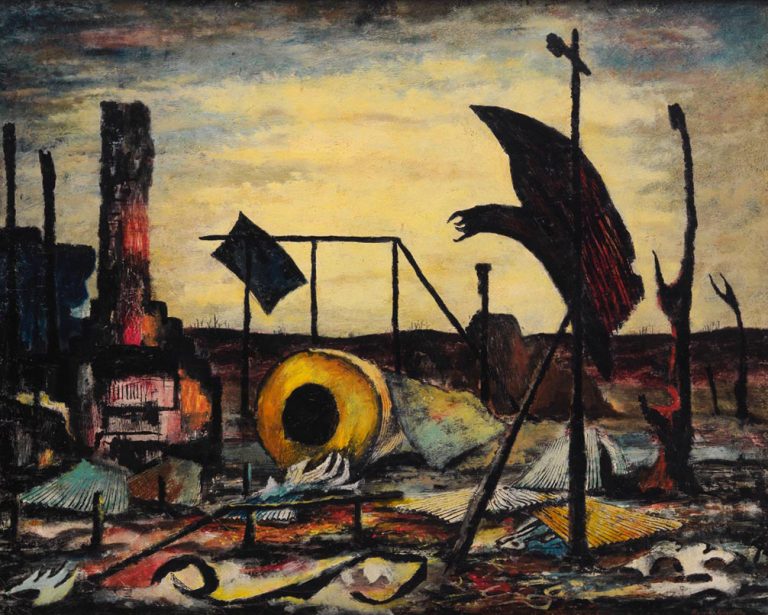We acknowledge the Traditional Owners of the land on which the Queensland Art Gallery | Gallery of Modern Art stands and recognise the creative contribution First Australians make to the art and culture of this country.

Russell Drysdale / Australia 1912–81 / Bush fire 1944 / Oil and ink on canvas on composition board / 62 x 77cm / Gift of Captain Neil McEacharn, Italy through C.L. Harden 1954 / Collection: Queensland Art Gallery | Gallery of Modern Art / © QAGOMA
Russell DrysdaleBush fire 1944
Not Currently on Display
Russell Drysdale’s landscapes are shaped by the vast, silent gravity of the Australian outback. The central concerns of his work are: the figure in the landscape; the isolation experienced in rural Australia; and the desolation after a disaster, as can be seen in Bush fire.
Drysdale himself said that the landscape ‘only becomes really interesting with the presence of people’. Yet, in Bush fire, it is the absence of people that is significant, with only the brick chimney — the hearth of the home — and parts of the building’s frame left standing. As writer Margaret Plant has noted:
The dramatised light heightens the apocalyptic feeling. The silhouette effect, the strange geometries wrought by sand, wind and heat, are characteristic of the artist’s compositional skill and his directing and choreographing of elements of the landscape . . . Drysdale saw beauty as well as pain in the outback.1
Endnotes:
1. Margaret Plant, ‘Silence reigns here: Russell Drysdale and the Australian landscape’, in Brought to Light: Australian Art 1850–1965, Queensland Art Gallery, Brisbane, 1998, pp.188–91.
Russell Drysdale was born in England in 1912 to a family that had a long association with Australia’s pastoral history. As a child, Drysdale travelled to Australia twice, visiting his uncle at ‘Pioneer’, a sugar plantation that the family had owned since 1889, in the northern Queensland town of Ayr. In 1923, his parents settled in Melbourne, and later acquired ‘Boxwood Park’, a sheep station in the Riverina region of New South Wales.
In 1931, Drysdale attended the George Bell Art School in Melbourne, where he was introduced to the European modern masters; the following year, he travelled to Europe to study the originals. Venetian paintings were also an important influence on his work.
On his return to Australia, Drysdale decided to make painting his career and studied at the Bell-Shore School from 1935 to 1938. George Bell was the ideal teacher for Drysdale and gave him a deep understanding of the material, structural and design aspects of painting.
Discussion Questions
Explain how the application of paint, the composition and tonal qualities of Bush fire influence your reaction to the piece.
Classroom Activities
Paint your own representation of a bushfire using colours found in Drysdale’s work. Create jagged forms and swirling movements by applying, layering, moving and removing paint using recycled cardboard and found foilage.